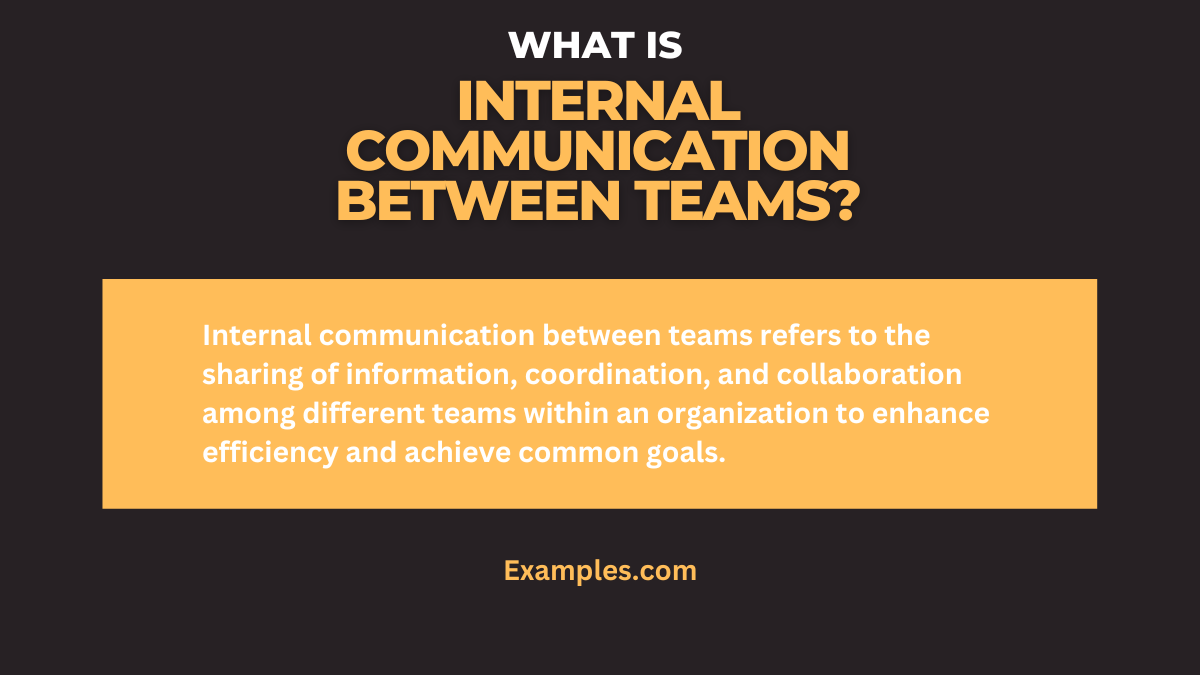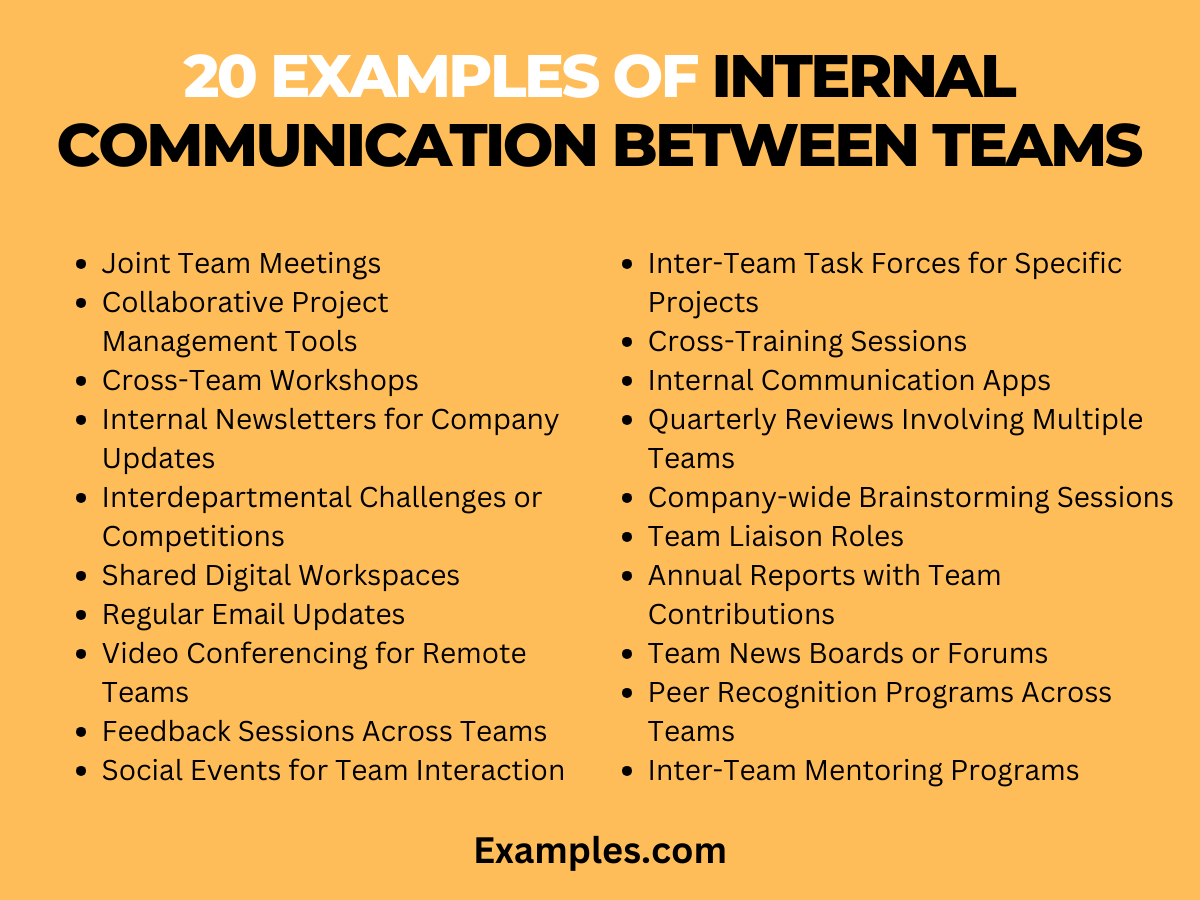19+ Internal Communication between Teams Examples
Embark on a journey to master Internal Communication between Teams with this comprehensive guide. Packed with practical Internal Communication Examples, it delves into strategies that bridge communication gaps between teams, enhancing collaboration and efficiency. From digital tools to interpersonal techniques, discover how effective team communication can transform workplace dynamics, foster innovation, and drive organizational success. This guide is an indispensable resource for creating a cohesive and productive team environment in any organization.
What is Internal Communication between Teams? – Definition

Internal Communication between Teams refers to the way teams within an organization share information, collaborate, and coordinate with each other. This type of communication involves the exchange of ideas, updates, and feedback between different teams, such as sales, marketing, or product development. Effective internal communication between teams is essential for ensuring that all parts of the organization work together smoothly, helping to achieve common goals and maintain Internal Communication Functions. It’s a crucial part of Internal Communication in Organizations, impacting overall productivity and success.
20 Examples of Internal Communication between Teams
Explore the realm of Internal Communication between Teams through these 20 unique and impactful examples. Each one showcases effective communication methods that facilitate collaboration and understanding among different teams within an organization. These examples cover a range of scenarios, illustrating how teams can share information, solve problems, and work together efficiently, embodying the best practices in Internal Communication Techniques.

- Joint Team Meetings: Regular meetings between different teams to discuss ongoing projects and objectives.
Example: “In our joint meeting, let’s align our marketing and sales strategies for the upcoming quarter.” - Collaborative Project Management Tools: Using tools like Trello or Asana for shared project tracking and updates. Example: “I’ve updated the project timeline on Asana, please add your team’s progress before the end of the week.”
- Cross-Team Workshops: Organizing workshops where members from various teams can learn and brainstorm together. Example: “This workshop will focus on integrating the efforts of our R&D and marketing teams.”
- Internal Newsletters for Company Updates: A newsletter that includes updates from different teams.
Example: “Our monthly newsletter will feature a section on the latest developments from the tech team.” - Interdepartmental Challenges or Competitions: Initiatives to foster healthy competition and collaboration between teams.
Example: “Let’s kick off the innovation challenge between the design and engineering teams this month.” - Shared Digital Workspaces: Platforms like Slack channels dedicated to specific projects involving multiple teams.
Example: “Join the Slack channel ‘Product Launch’ to stay updated and share your team’s input.” - Regular Email Updates: Sending updates via email to keep teams informed about each other’s progress.
Example: “We’ll send bi-weekly email updates to keep all teams informed about the project’s milestones.” - Video Conferencing for Remote Teams: Utilizing platforms like Zoom for meetings between geographically dispersed teams.
Example: “We have a Zoom call scheduled next Wednesday with the remote teams to discuss the client feedback.” - Feedback Sessions Across Teams: Sessions focused on sharing feedback between teams.
Example: “In our next session, we’ll discuss cross-team feedback on the new workflow process.” - Social Events for Team Interaction: Organizing informal events where team members can mingle and communicate.
Example: “The upcoming team-building retreat is a great opportunity for the marketing and sales teams to bond.” - Inter-Team Task Forces for Specific Projects: Creating task forces combining members from different teams for special projects.
Example: “We’ve formed a task force with representatives from product and support teams for the customer experience project.” - Cross-Training Sessions: Training sessions where members from one team train another team.
Example: “Our customer service team will conduct a session for the product team on customer insights.” - Internal Communication Apps: Using apps like Microsoft Teams for quick and efficient communication across teams.
Example: “Let’s use the Teams app for daily check-ins between the QA and development teams.” - Quarterly Reviews Involving Multiple Teams: Review meetings where teams share their achievements and challenges.
Example: “In our next quarterly review, each team will present their Q3 highlights and learning points.” - Company-wide Brainstorming Sessions: Sessions where teams collaborate to generate ideas on company-wide challenges.
Example: “The upcoming brainstorming session will involve all teams to ideate on increasing operational efficiency.” - Team Liaison Roles: Appointing team members to act as liaisons between different teams.
Example: “John from the tech team will be the liaison for the marketing team on the tech integration project.” - Annual Reports with Team Contributions: Preparing reports that include achievements and contributions from all teams.
Example: “The annual report will feature a section on each team’s contributions to our overall goals.” - Team News Boards or Forums: Physical or digital boards for teams to post updates and news.
Example: “Check the team news board for weekly updates from the HR and finance teams.” - Peer Recognition Programs Across Teams: Recognition programs that encourage acknowledging contributions from members of different teams.
Example: “Nominate someone from another team who has helped your team succeed, for the monthly peer recognition award.” - Inter-Team Mentoring Programs: Mentoring programs that pair members from different teams for knowledge exchange.
Example: “Our inter-team mentoring program pairs a member from the engineering team with someone from the business development team.”
These Internal Communication Examples demonstrate the variety and creativity in approaches to foster effective communication between teams, crucial for driving collaboration and success in any organization.
How to Improve Internal Communication on Teams
Enhancing Internal Communication on Teams is key to building a cohesive and efficient work environment. Here’s how organizations can improve communication among different teams:
- Establish Clear Communication Goals: Define specific objectives for internal team communication. This helps in aligning efforts and ensures that all team members understand the importance of effective communication.
- Use the Right Communication Tools: Implementing the right Internal Communication Platforms/ Tools can drastically improve the way teams communicate. Tools like Slack, Microsoft Teams, or project management software help in keeping conversations organized and accessible.
- Encourage Regular Inter-Team Meetings: Schedule regular meetings between teams to discuss ongoing projects, share updates, and address any challenges. This fosters a sense of collaboration and keeps everyone informed.
- Create a Culture of Openness and Transparency: Promote an organizational culture where teams feel comfortable sharing ideas, feedback, and concerns. Openness leads to more innovative and effective problem-solving.
- Develop a Feedback System: Implement a system where teams can give and receive feedback on communication practices. This helps in identifying areas for improvement and encourages continuous development.
- Facilitate Cross-Team Collaboration: Encourage collaboration on projects that require input from multiple teams. This not only improves communication but also helps in achieving more comprehensive results.
- Train Employees on Communication Skills: Provide training sessions focused on developing effective communication skills. This can include workshops on active listening, clear messaging, and constructive feedback.
- Monitor and Review Communication Strategies: Regularly assess the effectiveness of communication strategies and make adjustments as needed. This ensures that communication methods remain effective and relevant.
Tips for Internal Communication Between Teams
To further strengthen Internal Communication Between Teams, here are some practical tips:
- Clarify Roles and Responsibilities: Clearly define the roles and responsibilities within and between teams. This clarity prevents overlap and confusion, leading to more efficient communication.
- Implement Collaborative Platforms: Utilize collaborative platforms that allow teams to work together seamlessly, even when not physically together. This includes shared digital workspaces and cloud-based tools.
- Promote Informal Communication Channels: Alongside formal communication, encourage informal interactions among team members. Casual conversations can foster better relationships and open communication lines.
- Use Visual Aids for Complex Information: When communicating complex information, use visual aids like charts, graphs, and infographics to ensure clarity and better understanding.
- Set Up Inter-Team Liaisons: Appoint liaison personnel in teams to facilitate smoother communication and coordination between different groups.
- Celebrate Successes Together: Recognize and celebrate the achievements of different teams. This not only boosts morale but also encourages teams to communicate and work together more effectively.
- Encourage Team-Building Activities: Regular team-building activities can break down barriers and improve trust and communication between team members.
By implementing these strategies and tips, organizations can significantly improve Internal Communication between Teams, leading to a more collaborative, productive, and harmonious workplace environment.
Effective Internal Communication between Teams is pivotal for organizational success, fostering collaboration, understanding, and efficiency. This guide has provided strategies and tips to enhance team communication, essential for navigating today’s complex work environments. By embracing these practices, organizations can ensure that their teams are not only well-informed and connected but also aligned with the company’s goals, driving towards collective success and growth.



